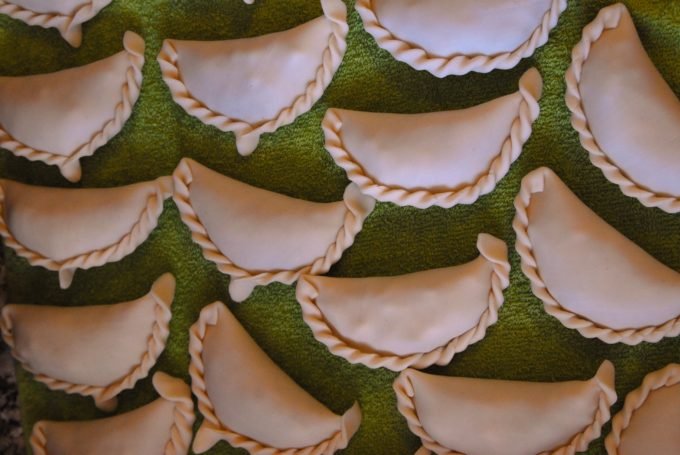
A tale about the World Cup, empanadas, and obsession in Argentina

A tale about the World Cup, empanadas, and obsession in Argentina
Empanadas in Córdoba
It’s a Saturday in the early stages of the World Cup and my wife, daughter, and I are in a taxi in Córdoba, Argentina, headed to my in-laws’ apartment. The streets are empty. The car rises and dips with irregularities in the road and veers for potholes. Like other Argentine cities, Cordoba is a jumble of concrete forming a disordered jigsaw skyline. Buildings are in construction or disrepair; there is graffiti and overflowing dumpsters.
But we don’t notice because we’re listening. The taxi’s radio rattles with pregame football commentary.
We enter in my in-laws’ kitchen to frenetic energy. In 30 minutes, Argentina’s opening World Cup match against Iceland starts, and they’re madly preparing empanadas.
The whole table has been co-opted for the operation. The morning paper, a basket of remaining biscuits, and a wooden máte are pushed aside. A worn tablecloth lies over the work area and atop it a dozen pallid masas—flat circles of dough.
“What can I do, Goyo?” I ask my father-in-law.
He gestures to the masas as he spoons mounds of ground beef (cooked with onions, potatoes, hard-boiled eggs, cumin, and paprika), into the center of each.
Empanadas are an ideal accompaniment to football. Delicious and affordable, they bring people together. Like football, they’re a national favorite with innumerable varieties province to province, made in every house and sold on every block in the country—but Goyo’s are a step above. An empanada style from Argentina´s northern Catamarca province, they carry more picante, cumin, and paprika-stained sauce.
[Read: Chicken wings are everything Argentina is not]
In 1978, Argentina hosted the World Cup and won, during the military dictatorship. Football then and now, is a national obsession—and distraction. Whatever crime and matching inflation rates happen outside, all is forgotten watching the perfect green field.
We finish spooning beef into the masas. “And now, we fold.” Goyo fills a teacup with water. “Take your finger, moisten it and trace a circle around the dough. That’s how it sticks to itself.”
Then with the dough in his left hand he pinches the top between his right index finger and thumb—it sticks. Following the curve of the semicircle he seals it, not letting the juice escape. I follow his lead.
“And now the finishing touches,” he says. Methodically, he works his way around the arc, pinching, pulling, then curling the dough over—a spiral along the edge of the empanada.
Five minutes before kickoff, the master leaves to take his post in the living room, in front of the 55-inch screen. Messi, Di Maria, and the rest of the Argentine team are finishing warm-up for the national anthem. There’s a nervous tension between the kitchen and the living room. Graciela (my mother-in-law), Fernanda (my wife), and I frantically fold the rest of the empanadas.
Graciela puts half the empanadas on a baking sheet in the oven and the other twelve into a pot of boiling lard.
Kickoff. Players aligned, opening pass. “It’s started!” we yell. We’re fixated on the pale-blue and white players.
It’s 20 minutes into the first half when Fernanda enters with a wood tray, piled with deep-fried and oven-baked empanadas. We each grab one, intuitively folding a napkin around its base. The orange oily juice dribbles down the sides of the dough, staining our paper napkins.
Our hopes for our team are tied to the hopes for our country. Temporarily distracted from the reality outside, we are blissfully unaware of the imminent 1-1 draw. Football, family, and empanadas—outside forgotten, for now.